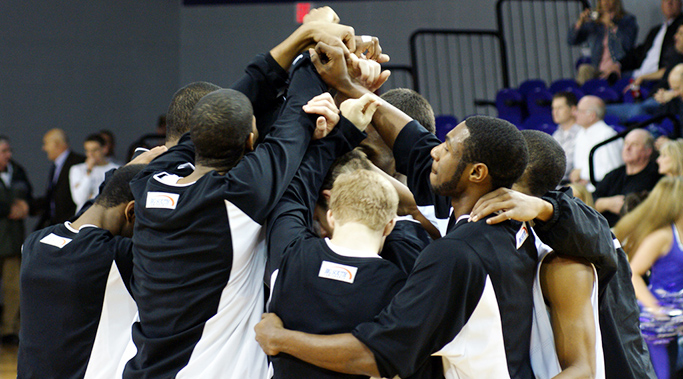The 4 pillars of team leadership
Motivation, communication, peer modeling and team cohesion develop strong captains

Winning isn’t everything — there are a number of other advantages people of all ages can gain from sports. One of those things is leadership, especially for high school students who have yet to reach their full potential.
At a Michigan High School Athletic Association clinic, sports psychologist Scott Pierce and former athletic director Scott Westfall, who works at the Institute for the Study of Youth Sports, shared the four pillars of leadership with the high school athletes in attendance. With a little motivation, good communication, a focus on positive peer modeling, and team cohesion, your athletes can become leaders on the court and in the classroom.
1. Motivation.
A leader’s role revolves around motivation — motivation to achieve team goals, improve various skills and become better people.It starts with training. Have your leaders promote the basics: Working out, or running a few extra laps. Ask them to push the team physically and motivate players who see no benefit in strength training.
Encourage your leaders to focus on their education — after all, it’s called education-based athletics. Make good grades a priority with your team.
» RELATED: Strengthening the bond between coach, team captain
Attitude is everything, especially in athletics. When things go wrong or your team loses the big game, look to your leaders to maintain a positive attitude. And let your leaders have a management role, especially when it comes to goal setting.
Goal setting is a multistep process. Pierce encourages captains to start with outcome goals and work backward.
- Outcome goals: “Focus on a competitive result of an event.” Whether it’s to win the championship or finish above .500, it needs to be realistic.
- Performance goals: “Focus on achieving specific standards of performance.” These goals should build up and increase the chances of achieving the outcome goal.
- Process goals: “Focus on the actions an individual must engage in during performance to execute or compete well.” These goals are typically specific actions you can do in practice to improve your team’s skills.
Once complete, ask your captains to share the results with your team. Is everyone in agreement? Implement and motivate, and allow your captains to do the same.
2. Communication.
“Can I give you some feedback?”
That’s how Westfall recommends you and your team leaders go about addressing a problematic situation.
“Be honest, positive, consistent, empathetic and respectful,” he said. “Be sure to praise and criticize the behavior — not the person. Never be sarcastic or demeaning.”
And remember to be an active listener.
“Have good eye contact,” Westfall said. “Lean forward, clasp your arms, nod and smile during the parts that resonate with you. Show interest by paraphrasing what you heard and ask follow-up questions.”
Ignore your cell phone and look at the person you’re speaking to. Show them that you’re interested in what they’re saying. Let them know you received the message.
3. Positive peer modeling.
“Captains are role models and everyone is watching,” Pierce said. “Your teammates will watch you in games and learn from the positive and negative consequences of your performance. Your teammates will watch you behave and act in practice and off the field and learn from the positive and negative consequences of your actions.”
Lead by example, Pierce said. Encourage your captains to be good citizens, compassionate, competitive, confident, encouraging and motivating, hard working, honest and trustworthy, humble and modest, a good listener, and a mediator.
If your captain is failing, your team will fail. If your captain is late to practice, the team will accept it as the norm. And if your captain isn’t dedicated to the sport, your team won’t be either.
4. Team cohesion.
The goal is to be a tighter team. How can this be accomplished?
 Schedule team dinners, team trips and team campouts. Get your team together outside of school and sport, Westfall said. Plan team fundraisers and encourage your athletes to work together toward a common goal.
Schedule team dinners, team trips and team campouts. Get your team together outside of school and sport, Westfall said. Plan team fundraisers and encourage your athletes to work together toward a common goal.
Try organizing a team skit night, Westfall said. Ask your seniors to dress up and make light of the coaching staff. The skits are typically centered on moments where the staff said or did something funny or went a little overboard in practice, he said.
It’s also important to participate in community service.
“Community service is great for a number of reasons,” Westfall said. “One, it brings everyone together. Two, the team is benefitting a person or group in the community. And three, the intrinsic feeling you have when you walk away that day knowing you made a difference. You cannot put a price tag on that feeling.”
Lastly, he said, attend a college-sporting event as a team. It doesn’t have to be a Saturday football game at a Division 1 university — it can be a free event at a local community college.
“Getting your team together, traveling, going to watch your sport performed at a higher level is a very special opportunity.”
Give your team a voice — allow them to create their own team-bonding events. Ask them to implement a plan and coordinate rides and schedules. Give your team responsibility, and they will come up with ideas that never crossed your mind.
Bring these ideas to your team — motivation, communication, positive peer modeling and team cohesion — and give them the ability to make a difference. Allow your captains to improve the atmosphere on your team and expect others to follow.
The four pillars of leadership can take your team to the next level.





